
|
Now it is bright as 8.7 mag (June 18, Marco Goiato). It stays bright as 9 mag for a while. In the Southern Hemisphere, it stays observable in good condition for a long time until the comet will fade out. In the Northern Hemisphere, it will be unobservable soon.
Date(TT) R.A. (2000) Decl. Delta r Elong. m1 Best Time(A, h)
June 23 18 13.50 -40 56.2 1.290 2.279 162 9.1 0:13 ( 0, 14)
June 30 17 43.78 -45 47.0 1.298 2.261 155 9.1 23:08 ( 0, 9)
|
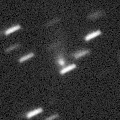
|
Now it is very bright as 8.8 mag (June 23, Chris Wyatt). In the Southern Hemisphere, it is observable from July to September, but it locates in extremely low. In the Northern Hemisphere, it is not observable until late December.
Date(TT) R.A. (2000) Decl. Delta r Elong. m1 Best Time(A, h)
June 23 4 50.55 10 31.0 1.822 0.959 22 10.1 3:00 (245,-15)
June 30 5 15.00 6 5.8 1.702 0.900 25 9.7 3:02 (250,-17)
|
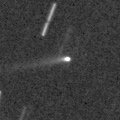
|
First return of a new periodic comet which brightened up to 13 mag in 2013. Now it is bright as 11.9 mag (June 23, Chris Wyatt). In the Southern Hemisphere, it stays observable in good condition all through this apparition. In the Northern Hemisphere, it is not observable at the high light from mid June to mid August.
Date(TT) R.A. (2000) Decl. Delta r Elong. m1 Best Time(A, h)
June 23 8 43.52 3 50.0 0.346 0.798 42 11.3 21:04 ( 97, -4)
June 30 8 22.65 -3 47.4 0.296 0.803 37 10.9 21:04 ( 98,-18)
|
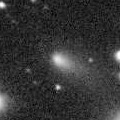
|
Now it is bright as 12.2 mag (June 23, Chris Wyatt). It will brighten rapidly, and brighten up to 7 mag from August to September. In the Northern Hemisphere, it will be observable in excellent condition. In the Southern Hemisphere, it will be unobservable from July to August. But it will be observable in good condition before and after that.
Date(TT) R.A. (2000) Decl. Delta r Elong. m1 Best Time(A, h)
June 23 21 9.87 45 31.9 0.923 1.480 99 11.7 3:00 (186, 79)
June 30 21 26.19 49 33.5 0.858 1.417 97 11.2 2:55 (180, 76)
|
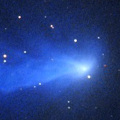
|
Now it is 11.5 mag (June 12, Juan Jose Gonzalez). It stays bright as 11 mag for a long time until autumn. In the Southern Hemisphere, it is not observable for a long time after this. In the Northern Hemispehre, it stays observable for a long time until the comet fades out. But it stays very low until autumn.
Date(TT) R.A. (2000) Decl. Delta r Elong. m1 Best Time(A, h)
June 23 7 20.76 51 12.3 3.459 2.645 31 11.3 21:04 (145, 12)
June 30 7 41.16 51 47.0 3.474 2.659 31 11.3 21:04 (146, 12)
|
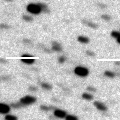
|
Now it is bright as 12.8 mag (June 24, Katsumi Yoshimoto). It is expected to approach to Sun down to 0.2 a.u. and brighten up to 3 mag in August. In the Northern Hemisphere, it stays observable in the morning sky until early August when the comet brightens up to 6 mag. It is not observable at all in the Southern Hemisphere.
Date(TT) R.A. (2000) Decl. Delta r Elong. m1 Best Time(A, h)
June 23 2 25.01 59 15.4 1.756 1.393 52 12.7 3:00 (217, 34)
June 30 2 56.71 59 25.2 1.586 1.257 52 12.0 3:02 (217, 34)
|

|
Now it is 11.7 mag (June 12, Juan Jose Gonzalez). It stays 12 mag for a long time until spring in 2019. In the Northern Hemisphere, it stays observable in good condition for a long time, although it becomes unobservable temporarily from mid June to August. In the Southern Hemisphere, it is not observable until September.
Date(TT) R.A. (2000) Decl. Delta r Elong. m1 Best Time(A, h)
June 23 8 10.21 38 48.2 3.507 2.682 30 12.2 21:04 (130, 11)
June 30 8 14.80 36 41.4 3.558 2.676 25 12.2 21:04 (131, 6)
|
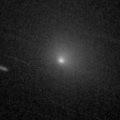
|
It brightened rapidly as expected. Now it is very bright as 11.1 mag (June 23, Chris Wyatt). It will fade out rapidly after this. In the Southern Hemisphere, it stays observable in excellent condition. It will be getting higher gradually after this also in the Northern Hemisphere.
Date(TT) R.A. (2000) Decl. Delta r Elong. m1 Best Time(A, h)
June 23 0 50.24 -24 16.5 0.919 1.371 90 12.3 3:00 (309, 10)
June 30 1 2.39 -22 29.8 0.923 1.405 92 13.1 3:02 (311, 14)
|
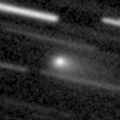
|
Now it is bright as 12.1 mag (June 23, Chris Wyatt). It will be observable at 12-13 mag in good condition from spring to summer. Juan Jose Gonzalez reported it was very bright as 10.5 mag on June 13.
Date(TT) R.A. (2000) Decl. Delta r Elong. m1 Best Time(A, h)
June 23 23 22.81 -4 16.9 1.155 1.683 101 13.2 3:00 (313, 39)
June 30 23 30.70 -2 28.7 1.121 1.704 105 13.2 3:02 (318, 44)
|
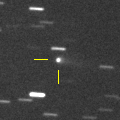
|
Now it is 14.1 mag (June 23, Chris Wyatt). It was expected to brighten up to 11 mag from summer to autumn. But actually, it is fainter than this ephemeris recently. It is observable in excellent condition in the Southern Hemisphere. It locates somewhat low in the Northern Hemisphere. Juan Jose Gonzalez reported it was very bright as 11.5 mag on June 19.
Date(TT) R.A. (2000) Decl. Delta r Elong. m1 Best Time(A, h)
June 23 22 21.18 -15 44.8 1.339 2.043 119 13.5 3:00 (336, 36)
June 30 22 28.05 -16 20.1 1.272 2.034 124 13.3 3:02 (343, 37)
|

|
Now it is 13.8 mag (June 13, Toshihiko Ikemura, Hirohisa Sato).
Date(TT) R.A. (2000) Decl. Delta r Elong. m1 Best Time(A, h)
June 23 23 19.94 0 51.4 5.514 5.779 100 13.4 3:00 (309, 43)
June 30 23 20.56 1 6.5 5.407 5.779 106 13.4 3:02 (318, 48)
|
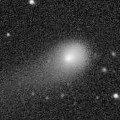
|
Now it is 13.6 mag (June 7, Thomas Lehmann). It will be observable at 12-13 mag for a long time from 2017 to 2018. In the Southern Hemisphere, it will be hardly observable after this.
Date(TT) R.A. (2000) Decl. Delta r Elong. m1 Best Time(A, h)
June 23 11 58.85 49 33.6 4.092 3.888 71 13.5 21:04 (128, 52)
June 30 11 53.27 48 6.8 4.204 3.906 66 13.6 21:04 (125, 47)
|
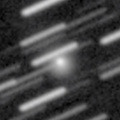
|
Now it is 14.2 mag (June 12, Toshihiko Ikemura, Hirohisa Sato). It will brighten up to 13 mag in 2019 spring. In the Northern Hemisphere, it stays observable in good condition for a long time. In the Southern Hemisphere, it locates extremely low until summer.
Date(TT) R.A. (2000) Decl. Delta r Elong. m1 Best Time(A, h)
June 23 17 52.01 44 50.2 3.308 3.802 111 14.4 23:44 (180, 80)
June 30 17 36.98 43 30.0 3.268 3.769 112 14.3 23:01 (180, 82)
|
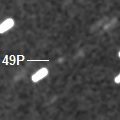
|
The condition is worst in this apparition. It brightens up to 14.5 mag from June to August, but it is not observable at all.
Date(TT) R.A. (2000) Decl. Delta r Elong. m1 Best Time(A, h)
June 23 5 31.16 15 35.3 2.434 1.451 11 15.0 3:00 (234,-19)
June 30 5 54.50 16 30.9 2.422 1.440 11 14.8 3:02 (235,-17)
|

|
Now it is 19.2 mag (June 13, Toshihiko Ikemura, Hirohisa Sato). It will brighten rapidly, and it is expected to brighten up to 10 mag in autumn. But actually, it is much fainter than this ephemeris. It will be observable in excellent condition in the Northern Hemisphere. It stays low in the Southern Hemisphere.
Date(TT) R.A. (2000) Decl. Delta r Elong. m1 Best Time(A, h)
June 23 23 7.34 -1 30.9 1.566 2.062 103 15.2 3:00 (315, 43)
June 30 23 16.31 0 12.9 1.450 2.010 107 14.9 3:02 (320, 48)
|

|
Now it is 15.2 mag (May 21, Martin Masek). It stays 15 mag from 2018 to 2019, and it will be observable for a long time in the Southern Hemisphere. In the Northern Hemisphere, it will never be observable again.
Date(TT) R.A. (2000) Decl. Delta r Elong. m1 Best Time(A, h)
June 23 11 58.57 -65 33.4 3.911 4.372 110 15.1 21:04 ( 19,-17)
June 30 11 59.53 -65 7.2 3.933 4.346 107 15.1 21:04 ( 21,-19)
|

|
It brightened up to 7.1 mag from May to June in 2017 (June 21, Juan Jose Gonzalez). Now it is fading. It has already faded down to 14.8 mag (May 23, Martin Masek). In the Southern Hemisphere, it stays observable for a long time after this. It will never be observable again in the Northern Hemisphere.
Date(TT) R.A. (2000) Decl. Delta r Elong. m1 Best Time(A, h)
June 23 1 53.64 -44 45.2 4.546 4.642 89 15.3 3:00 (316,-13)
June 30 1 58.34 -45 22.8 4.545 4.706 92 15.3 3:02 (319,-10)
|

|
Now it is 16.4 mag (June 21, Katsumi Yoshimoto). It will brighten rapidly after this, and it is expected to brighten up to 9 mag from autumn to winter. In the Northern Hemisphere, it will be getting higher gradually after July. Then it stays observable in good condition for a long time until it fades out. In the Southern Hemispehre, it is observable in good condition until autumn, but it will be low in winter.
Date(TT) R.A. (2000) Decl. Delta r Elong. m1 Best Time(A, h)
June 23 2 14.11 -2 55.1 2.623 2.328 62 15.8 3:00 (279, 8)
June 30 2 27.55 -1 50.9 2.505 2.271 65 15.4 3:02 (281, 12)
|

|
Now it is 17.5 mag (June 18, Martin Masek). It is observable at 15 mag in 2018, in good condition in the Southern Hemisphere. It locates somewhat low in the Northern Hemisphere.
Date(TT) R.A. (2000) Decl. Delta r Elong. m1 Best Time(A, h)
June 23 23 26.04 -15 10.3 2.739 3.155 104 15.5 3:00 (320, 29)
June 30 23 28.97 -15 15.8 2.662 3.168 110 15.4 3:02 (326, 33)
|

|
Now it is 14.7 mag (June 22, Toshihiko Ikemura, Hirohisa Sato). It stays at 14-15 mag for a long time from summer to winter. In the Southern Hemisphere, it stays observable in excellent condition for a while. But it will be getting lower rapidly in September, then it becomes unobservable after October. In the Northern Hemisphere, it stays observable for a long time until it fades out. But it stays extremely low.
Date(TT) R.A. (2000) Decl. Delta r Elong. m1 Best Time(A, h)
June 23 13 47.46 -34 21.3 1.964 2.662 123 15.7 21:04 ( 18, 18)
June 30 13 47.06 -31 4.5 1.981 2.600 116 15.6 21:04 ( 25, 19)
|

|
It will brighten up to 14 mag in winter. It will be observable in excellent condition in the Northern Hemisphere. In the Southern Hemisphere, it is observable only until August.
Date(TT) R.A. (2000) Decl. Delta r Elong. m1 Best Time(A, h)
June 23 2 42.02 18 14.9 2.862 2.302 47 15.9 3:00 (258, 15)
June 30 2 53.20 20 29.6 2.763 2.268 51 15.8 3:02 (258, 20)
|
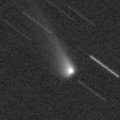
|
Now it is 17.2 mag (May 19, CAO, San Pedro de Atacama). Fading now. It stays observable in good condition for a long time after this in the Southern Hemisphere. It stays low in the Northern Hemisphere.
Date(TT) R.A. (2000) Decl. Delta r Elong. m1 Best Time(A, h)
June 23 1 0.45 -12 54.9 4.552 4.540 82 15.9 3:00 (299, 16)
June 30 0 59.79 -14 13.1 4.447 4.560 89 15.8 3:02 (306, 21)
|
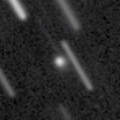
|
It brightened rapidly. Now it is 15.5 mag (June 12, Toshihiko Ikemura, Hirohisa Sato). It will be fading after this, and will be fainter than 18 mag in August.
Date(TT) R.A. (2000) Decl. Delta r Elong. m1 Best Time(A, h)
June 23 14 45.23 15 43.4 1.288 1.973 117 15.9 21:04 ( 17, 70)
June 30 14 48.16 11 32.2 1.334 1.986 114 16.1 21:04 ( 28, 64)
|

|
It brightened up to 14.8 mag in May (May 26, Ken-ichi Kadota). Now it is fading. But it is bright as 15.8 mag still now (June 12, Toshihiko Ikemura, Hirohisa Sato). It stays observable in good condition for a while. But it will fade out rapidly after this. It will be fainter than 18 mag in August.
Date(TT) R.A. (2000) Decl. Delta r Elong. m1 Best Time(A, h)
June 23 16 10.49 -19 28.0 1.138 2.095 153 16.0 22:01 ( 0, 36)
June 30 15 34.76 -16 24.6 1.271 2.133 137 16.3 21:04 ( 2, 39)
|
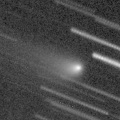
|
It is fading now, but it stays 16 mag until summer. But actually, it is 18.1 mag (Mar. 23, Toshihiko Ikemura, Hirohisa Sato), fainter than this ephemeris.
Date(TT) R.A. (2000) Decl. Delta r Elong. m1 Best Time(A, h)
June 23 16 39.89 -28 2.5 3.071 4.042 160 16.2 22:33 ( 0, 27)
June 30 16 25.77 -27 45.1 3.173 4.090 150 16.3 21:51 ( 0, 27)
|

|
Now it is 16.2 mag (June 17, Jean-Francois Soulier). It stays 16 mag for a while. In the Southern Hemisphere, it stays observable until August, but it will be unobservable after that. In the Northern Hemisphere, it becomes observable in good condition after this. Its cometary activity was observed on Mar. 26 (M. Mommert, D. Polishook, N. Moskovitz).
Date(TT) R.A. (2000) Decl. Delta r Elong. m1 Best Time(A, h)
June 23 1 47.67 9 28.1 1.500 1.376 62 16.2 3:00 (273, 21)
June 30 1 59.75 13 12.8 1.494 1.416 65 16.2 3:02 (272, 27)
|
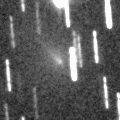
|
It was predicted to be at 16.5 mag. But actually, it is fainter than 19.5 mag (June 17, Martin Masek). It will be observable in good condition after this in the Southern Hemisphere. But it stays low in the Northern Hemisphere.
Date(TT) R.A. (2000) Decl. Delta r Elong. m1 Best Time(A, h)
June 23 21 6.60 -32 41.1 1.315 2.189 139 16.5 3:00 (359, 23)
June 30 20 29.08 -37 28.4 1.305 2.252 151 16.6 2:01 ( 0, 18)
|
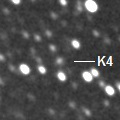
|
Now it is 17.2 mag (May 21, Toshihiko Ikemura, Hirohisa Sato). It was observed at 16 mag from summer to autumn in 2017. It will be observable at 16.5 mag in good condition also in 2018. It locates somewhat low in the Southern Hemisphere.
Date(TT) R.A. (2000) Decl. Delta r Elong. m1 Best Time(A, h)
June 23 0 46.03 20 12.8 3.254 3.116 73 16.5 3:00 (271, 39)
June 30 0 52.05 21 29.1 3.204 3.152 77 16.5 3:02 (274, 45)
|
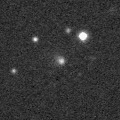
|
Unexpectedly, it brightened rapidly. Now it is 16.6 mag (May 15, Toshihiko Ikemura, Hirohisa Sato). It stays at 16.5 mag until July.
Date(TT) R.A. (2000) Decl. Delta r Elong. m1 Best Time(A, h)
June 23 12 46.91 0 41.0 1.657 2.078 99 16.5 21:04 ( 52, 42)
June 30 12 55.51 0 2.7 1.719 2.069 94 16.6 21:04 ( 56, 39)
|

|
Now it is 16.5 mag (June 17, Martin Masek). It will be fading slowly until summer.
Date(TT) R.A. (2000) Decl. Delta r Elong. m1 Best Time(A, h)
June 23 11 37.48 9 9.9 3.608 3.574 79 16.7 21:04 ( 75, 35)
June 30 11 42.49 8 24.3 3.707 3.578 74 16.8 21:04 ( 78, 30)
|
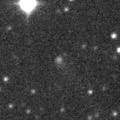
|
Now it is 16.9 mag (May 15, Toshihiko Ikemura, Hirohisa Sato). It will be fainter than 18 mag in summer.
Date(TT) R.A. (2000) Decl. Delta r Elong. m1 Best Time(A, h)
June 23 14 28.11 -4 51.4 5.882 6.512 124 17.0 21:04 ( 16, 49)
June 30 14 27.21 -4 20.2 6.000 6.533 117 17.0 21:04 ( 26, 47)
|

|
Now it is 17.1 mag (June 13, Toshihiko Ikemura, Hirohisa Sato). It will be fading gradually after this, and it will be fainter than 18 mag in winter. In the Northern Hemisphere, it stays observable in good condition for a long time. In the Southern Hemisphere, it will never be observable again.
Date(TT) R.A. (2000) Decl. Delta r Elong. m1 Best Time(A, h)
June 23 23 41.32 73 35.1 7.604 7.306 69 17.0 3:00 (195, 47)
June 30 23 45.07 74 16.5 7.598 7.330 70 17.0 3:02 (193, 48)
|
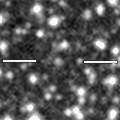
|
Now it is 17.9 mag (June 13, Toshihiko Ikemura, Hirohisa Sato). It stays observable at 17 mag in good condition from spring to autumn.
Date(TT) R.A. (2000) Decl. Delta r Elong. m1 Best Time(A, h)
June 23 21 1.57 1 53.0 5.284 5.991 130 17.1 2:59 ( 0, 57)
June 30 21 0.61 2 3.1 5.215 5.992 136 17.0 2:30 ( 0, 57)
|
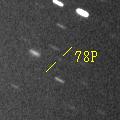
|
Now it is 17.2 mag (June 13, Toshihiko Ikemura, Hirohisa Sato). It stays at 13 mag for a long time from winter to autumn in 2019. It stays observable in good condition until winter when the comet brightens up to 13 mag.
Date(TT) R.A. (2000) Decl. Delta r Elong. m1 Best Time(A, h)
June 23 22 3.02 -3 39.7 2.293 2.930 119 17.8 3:00 (337, 49)
June 30 22 3.93 -3 18.6 2.185 2.898 125 17.6 3:02 (348, 51)
|
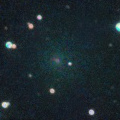
|
It brightened very rapidly, and it brightened so much up to 11.8 mag in May (May 16, Juan Jose Gonzalez). It seems to be fading rapidly after that. It has already faded down to 16.9 mag (June 1, Yuji Ohshima). In the Northern Hemisphere, it stays observable until it fades out. It is not observable in the Southern Hemisphere.
Date(TT) R.A. (2000) Decl. Delta r Elong. m1 Best Time(A, h)
June 23 4 9.13 84 48.4 1.817 1.613 62 20.0 3:00 (186, 33)
June 30 3 28.07 85 22.5 1.816 1.641 63 20.4 3:02 (186, 35)
|
|
![]()
 C/2017 B3 ( LINEAR )
C/2017 B3 ( LINEAR ) C/2015 V2 ( Johnson )
C/2015 V2 ( Johnson ) 38P/Stephan-Oterma
38P/Stephan-Oterma 65P/Gunn
65P/Gunn C/2018 L2 ( ATLAS )
C/2018 L2 ( ATLAS ) (944) Hidalgo
(944) Hidalgo C/2015 V1 ( PanSTARRS )
C/2015 V1 ( PanSTARRS ) C/2018 C2 ( Lemmon )
C/2018 C2 ( Lemmon ) C/2018 K1 ( Weiland )
C/2018 K1 ( Weiland ) C/2015 VL62 ( Lemmon-Yeung-PanSTARRS )
C/2015 VL62 ( Lemmon-Yeung-PanSTARRS ) (3552) Don Quixote
(3552) Don Quixote C/2017 S6 ( Catalina )
C/2017 S6 ( Catalina ) C/2017 K4 ( ATLAS )
C/2017 K4 ( ATLAS ) 105P/Singer Brewster
105P/Singer Brewster 74P/Smirnova-Chernykh
74P/Smirnova-Chernykh C/2017 E3 ( PanSTARRS )
C/2017 E3 ( PanSTARRS ) C/2014 OE4 ( PanSTARRS )
C/2014 OE4 ( PanSTARRS ) C/2017 M5 ( TOTAS )
C/2017 M5 ( TOTAS ) 78P/Gehrels 2
78P/Gehrels 2 C/2018 EF9 ( Lemmon )
C/2018 EF9 ( Lemmon )![]()




























